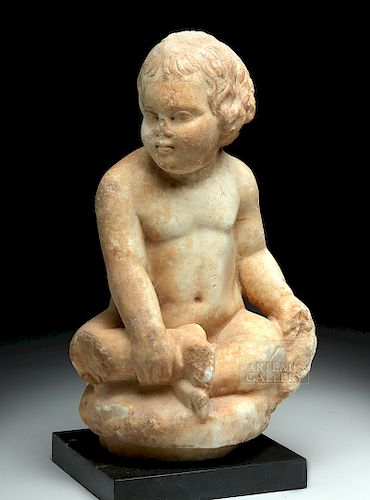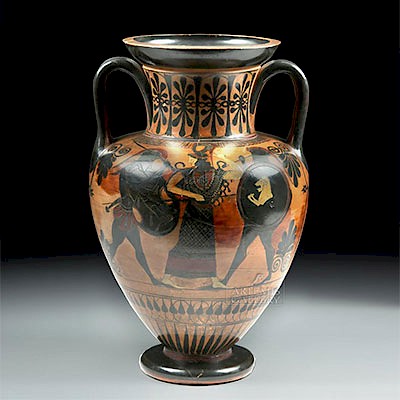Published Roman Marble Seated Boy w/ Grapes
Lot 32
About Seller
Artemis Fine Arts
686 S Taylor Ave, Ste 106
Louisville, CO 80027
United States
Selling antiquities, ancient and ethnographic art online since 1993, Artemis Gallery specializes in Classical Antiquities (Egyptian, Greek, Roman, Near Eastern), Asian, Pre-Columbian, African / Tribal / Oceanographic art. Our extensive inventory includes pottery, stone, metal, wood, glass and textil...Read more
Estimate:
$15,000 - $25,000
Absentee vs Live bid
Two ways to bid:
- Leave a max absentee bid and the platform will bid on your behalf up to your maximum bid during the live auction.
- Bid live during the auction and your bids will be submitted real-time to the auctioneer.
Bid Increments
| Price | Bid Increment |
|---|---|
| $0 | $25 |
| $300 | $50 |
| $1,000 | $100 |
| $2,000 | $250 |
| $5,000 | $500 |
| $10,000 | $1,000 |
| $20,000 | $2,500 |
| $50,000 | $5,000 |
| $100,000 | $10,000 |
| $200,000 | $20,000 |
About Auction
By Artemis Fine Arts
Oct 11, 2018
Set Reminder
2018-10-11 10:00:00
2018-10-11 10:00:00
America/New_York
Bidsquare
Bidsquare : Exceptional Antiquities | Ethnographic Art
https://www.bidsquare.com/auctions/artemis-gallery/exceptional-antiquities-ethnographic-art-3500
An important one-day auction featuring museum-worthy examples of classical antiquities, ancient and ethnographic art from cultures encompassing the globe. Artemis Fine Arts info@artemisfinearts.com
An important one-day auction featuring museum-worthy examples of classical antiquities, ancient and ethnographic art from cultures encompassing the globe. Artemis Fine Arts info@artemisfinearts.com
- Lot Description
Roman, Imperial Period, ca. 1st to 2nd century CE. Finely carved in the round, an endearing marble sculpture of a sweet boy, sitting cross-legged on a round base, with his right foot over his left, as he turns his head to gaze toward the right, his body naturalistically rendered with "baby fat" and cherubic cheeks. Adding to the realism of the piece is his pose; notice how he grips his right shin in an adorable childlike manner. In the other hand, he holds a bunch of juicy grapes near his thigh - suggesting he represents the child Bacchus (Greek Dionysos). In addition to possessing an impressive understanding of anatomy and an ability to render flesh from stone, the sculptor of this piece was skilled in communicating verism via the facial features. It is not difficult to appreciate those generously lidded, almond-shaped eyes, plump apple cheeks, full lips, and that pudgy nose - framed by short bangs centrally parted over his forehead, a raised knot of hair atop, and wavy cascading ringlets. Size: 16" H (40.6 cm); 17.25" H (43.8 cm) on included custom stand.
The ancient Romans were the first civilization to cultivate grape vines. Grapes and wine of course were associated with Bacchus (identified in ancient Greece as Dionysos or Dionysus) - the Olympian god of wine, pleasure, ritual madness, ecstasy, and theatre who was sometimes depicted as a bearded adult but alternatively depicted as a youth, with a smooth face as we see in this statue. The cult of Bacchus was hugely popular, signifying the freedom created by wine, music, and ecstatic dance.
This piece was published in "Venerable Traditions: Works of Art from the Ancient World" (Fortuna Fine Arts , 2007). The description also describes the Hellenistic penchant for depicting youths in their visual culture: "Marble statues of children first appeared during the Hellenistic period, when they were among the favorite genre subjects. Alexandria was a center of production, as was Asia Minor. Children were often depicted with animals and some were also shown holding grapes. Furthermore, many were presented as the young divinities Herakles, Hermes, or Dionysos, depending on the attributes they held. With the grapes in the boy's left hand, this piece may have been intended to portray Dionysos as a child."
CF. a child with grapes in the Getty, inv. 73.AA.6, illustrated in Cornelius C. Vermeule, Greek and Roman Sculpture in America. Masterpieces in Public Collections in the United State and Canada (Berkeley, 1981), cat. No. 151, p. 184. For a seated boy with a goose, see Oskar Waldhauer, Die Antiken Skulpturen der Ermitage, vol. 2 (B. Bogajewski et al, eds., Archaeologische Mitteilungen aus Russischen Sammlungen, 3) (Berlin & Leipsig, 1931), cat. No. 197, pp. 68, pl. 50. For a standing boy with similar hairstyle and holding grapes and a bird, see Herbert Hoffman, Ten Centuries that Shaped the West (Houston, 1970), cat. No. 13, pp. 41-43. For a seated boy with a dolphin adapted as a fountain jet, see John Ward-Perkins & Amanda Claridge, Pompeii AD 79 (Boston, 1978), cat. No. 72, pp. 142-143.
Provenance: private East Coast, USA collection; ex Gorny & Mosch, December 12, 2006, #154; ex Gorny & Mosch, July 11, 2006, #150; published in "Venerable Traditions: Works of Art from the Ancient World" (Fortuna Fine Arts , 2007)
All items legal to buy/sell under U.S. Statute covering cultural patrimony Code 2600, CHAPTER 14, and are guaranteed to be as described or your money back.
A Certificate of Authenticity will accompany all winning bids.
We ship worldwide and handle all shipping in-house for your convenience.
#138602Head reattached. Losses to nose, left hand, right knee and toes, and base. Expected surface wear with nicks and earthen deposits as shown. Traces of pigment and/or mineral deposits on coiffure. Otherwise very good and quite rare. Old inventory label numbered 8613 on the base.Condition
- Shipping Info
-
All shipping is handled in-house for your convenience. Your invoice from Artemis Gallery will include shipping calculation instructions. If in doubt, please inquire BEFORE bidding for estimated shipping costs for individual items.
-
- Buyer's Premium



 EUR
EUR CAD
CAD AUD
AUD GBP
GBP MXN
MXN HKD
HKD CNY
CNY MYR
MYR SEK
SEK SGD
SGD CHF
CHF THB
THB














